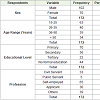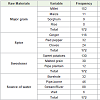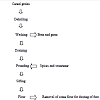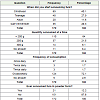Research Article
Appraisal of Fura Processing and Consumption Pattern in Ankpa Local Government Area, Kogi State, Nigeria
Yusufu PA1,2*, Abu JO2, Igyor MA2, Chinma CE3 and Onuh JO1
1Department of Food, Nutrition and Home Sciences, Kogi State University, Anyigba, Kogi State, Nigeria
2Department of Food Science and Technology, Federal University of Agriculture, Makurdi, Benue State, Nigeria
3Department of Food Science and Technology, Federal University of Technology, Minna, Niger State, Nigeria
Corresponding author: Yusufu Peter Awodi, Department of Food, Nutrition and Home Sciences, Kogi State University,Anyigba, Kogi State, Nigeria, Tel: 07061024372; E-mail:yusufu.pa@ksu.edu.ng
Citation: Yusufu PA, Abu JO, Igyor MA, Chinma CE, Onuh JO. Appraisal of Fura Processing and Consumption Pattern in Ankpa Local Government 02 Area, Kogi State, Nigeria. Indian J Nutri. 2017;4(2): 158.
Copyright © 2017 Yusufu PA, et al. This is an open access article distributed under the Creative Commons Attribution License, which permits unrestricted use, distribution, and reproduction in any medium, provided the original work is properly cited.
Indian Journal of Nutrition | ISSN: 2395-2326 | Volume: 4, Issue: 2
Submission: 13/02/2017; Accepted: 10/03/2017; Published: 25/04/2017
Abstract
Background: Fura serves as dietary staple food and beverages for many adults, but it is considered to be of lower nutritive value due to its low protein content and limitation in essential amino acids. Traditional fura in dumpling form has a limited shelf life.
Objectives: A survey on the processing practices and consumption pattern of fura a traditional cereal-based-food product was conducted to be able to provide information that would be used to improve on the nutritional quality and acceptability of fura.
Methodology: Purposive sampling was used to select four (4) areas in Ankpa local government in Kogi State. Simple random sampling was used to select 200 respondents from the four (4) areas. Semi structured questionnaire and interview were procedures employed for data collection.
Results: The results showed that majority (40.6%) of the respondents had primary education and therefore ill equipped to appreciate nutritional composition of food. Majority (88.4%) of respondents indicated the use of millet as the major grain for fura processing. 51% of the respondents use stream/river water to process fura. This has implication on the safety of fura for consumption. 75.6% interviewed had no knowledge on the nutritional quality of fura. The study indicated that 91.2% of the respondents were favorably disposed to the idea of powdered fura while 93.6% expressed willingness to accept protein improved fura. The three most preferred protein sources were Soybean groundnut and cashew nut.
Conclusion: The study ascertained the willingness of respondents to accept nutritionally improved powdered fura.
Keywords:
Fura; Nutritional quality; Protein content; Respondents
Introduction
Fura is one of the several indigenous food products made from cereals in West Africa particularly Nigeria, Ghana and Burkina Faso[1]. Fura is mainly produced from moist cereal flour, blended with spices, compressed into balls and boiled for 30 minutes. While still hot, the cooked dough is worked in the mortar with the pestle (with addition of hot water) until a smooth, slightly elastic, cohesive lump (fura) is formed. The fura dough is rolled into balls by hand anddusted with flour [2-4]. Fura is made into porridge by crumbling the fura balls into ‘nono’ (local yoghurt produced from cow milk) this food combination is called “fura dan nono” or mashed in water before consumption in the form of porridge [5]. Sugar or honey may be added to taste. Fura serves as a staple food and beverage for many adults and weaning food for infants [4].
Cereals are considered to be of lower nutritive value due to theirlow protein content and limitations in certain essential amino acidssuch as lysine and threonine [6-8]. Like most cereal-based foods, fura is a good source of carbohydrates but low in protein and fat [9]. This makes fura nutritionally deficient. Increasing nutritional awareness of today’s consumers continue to decrease the acceptance of such products [10]. Supplementation of commonly consumed cereal-based foods with inexpensive plant protein sources has been exploited to improve the protein quality of staple foods through a mutual complementation of their limiting amino acids [10].
This paper presents the results of a survey on the traditional production and consumption pattern of fura. The objective is to document such baseline information needed to provide guidelines for upgrading the production and nutritional quality of the product.
Methodology
Study area
The study was carried out in Ankpa Local Government Area of Kogi State, Nigeria between the months of January and May, 2015. The locations used were Angwa, Enokwoli, Owelle and Allor. These are the major fura producing and consuming areas in Ankpa local government. Ankpa has an area of 1,200 km2 with a population of 267,353 at the 2006 census [11]. The inhabitants are mainly traders and farmers.
Sampling procedure
Purposive sampling was used to select four areas where fura is heavily produced and consumed. Simple random sampling was used to select 50 respondents each from the four locations making a total of 200 respondents. The respondents were made up of persons who produce and also consume fura. Respondents gave verbal informed consent to participate in the study.
Instrumentation
The survey was in the form of a semi-structured questionnaire and interview. The questionnaire was divided into three sections (A, B and C). Section A was developed to obtain the socio-demographic information about the respondents such as sex, age, educational level and the profession. Section B contained questions to enable researchers determine the raw materials used in producing fura. Section C was designed to obtain information on the consumption pattern as well as information that would be used to improve on the nutritional quality and acceptability of fura.
Data collection
A total of 200 questionnaires were personally administered to processors and consumers of fura who were randomly selected. The questionnaires were completed by the respondents in their homes, market and offices. There was agreement on when the completed questionnaire could be picked up. Where the respondents could not speak English, interviews were conducted in the local language (Igala). Questionnaires (172) representing 86% were retrieved. The remaining 14% were either reluctant to return their questionnaire or could not be located.
Data analysis
Data collected was statistically analyzed using descriptive statisticssuch as frequency and percentages as described by Rangaswamy [12].
Results and Discussion
Socio-demographic characteristic of respondents
Socio-demographic characteristics of respondents are presented in Table 1. A total of 172 persons responded to the questionnaire. Results of sex distribution among respondents indicated that 59.3% were male and 40.7% were female. This seems to suggest that males are beginning to get involved in local food processing hitherto termed a ‘female affair’. Victoria et al. reported 27.5% of male who were processors/consumers of fura in some Northern states of Nigeria [2]. The ages of the respondents, shown in Table 1 indicated that 36.6% were aged between 15 and 25 years, 23.3% were aged between 26-35 years; 20.3% were aged between 36-50 years and 19.7% were above 50 years. The age distribution of the respondents showed that younger persons (15-25 years) representing 36.6% are involved in fura processing/consumption. It would appear therefore that the younger persons appreciate fura in terms of processing and consumption. This finding is not in line with a study by Ingbian and Akpapunam [8], who reported that traditional foods are most popular only among the elderly.
Results on educational level of the respondents as shown in Table 1 indicate that 40.6% had primary education, 20.9% had secondary education, and 25.5% had no formal education, while only 12.8% had tertiary education. Involvement of persons with no formal education(25.5%) and people with primary education (40.6%) may contribute to improper hygiene practices during production and handling of fura which could lead to products with potential health hazards to the consumer. The uneducated and semi illiterates are ill equipped to appreciate modern methods of food hygiene, handling and processing. It is surmised that poor hygienic handling of fura is one of the reasons why utilization of fura is not very popular among the elites [13].
Fura Processing Materials and Ingredients
Table 2 shows the raw materials used for fura production. Millet is the significant (88.4%) raw cereal grain used to produce fura while 6.4% and 5.2% use maize and sorghum respectively. Even though it was noted that rice could equally be used by those interviewed, none of them indicated ever using it to produce fura. There is, however, a need to supplement fura since it is completely a cereal based food product which is deficient both in protein quantity and quality [14]. Spices added to cereal flour for fura processing are presented in Table 2. These were ginger (Zingiber officinale) 67.4%, and red pepper (Capsicum frutescens) 18.6%. It was noted that cloves (Syzygium aromaticum) could also be added (13.9%) as an ingredient but impacts a bitter taste. These ingredients are added as spices either alone or in combination. Ginger, red pepper and cloves act as antiinflammatory, antioxidant, antimicrobial and neuro-protective agents against cerebral insufficiency in the elderly [15]. Table 2 shows sweetener added to fura. More than half of the respondents (76%) use sweet potatoes while 17.4% use malted grains. Very few respondents (7%) use ripe plantains. The choice of sweet potatoes over malted grains and ripe plantain could be that sweet potatoes impact more sweetness.
Table 2 shows the source of water used to process fura. Majority (51%) of the respondents use stream/river water, 27% use pipeborne water, 18.6% use borehole water while 3.4% use well water. The quality of water used to process food materials is significant to the overall quality of the final products [13]. Fura is reported to have short shelf life [16]. The use of pipe-borne water to process fura would therefore be more appropriate. The use of stream or river water which is the commonest practice in this local government to process fura, could pose health hazards on consumers. Stream and river water are documented to be sources of coli form group of bacteria that cause food borne diseases [13].
The flow diagram of fura production process is shown in Figure 1. The information gathered from the respondents through interview showed that, there exists no variation in the procedure adopted for the traditional method of processing fura. This finding is in concordance with the traditional method of fura processing reported by Filli et al.[1].
Consumption pattern and nutritional information on fura
Table 3 shows the consumption pattern and the nutritional information of the respondents on fura. The majority (40.1%) of the respondents indicated that they started consuming fura from childhood, 27.9% began consuming fura as teenagers, while 11.6% of respondent indicated that they started consuming fura as adults. Other respondents (20.3%) could not remember when they began to consume fura. The high percentage (40.1%) of respondents who began to consume fura from childhood is an indication that fura is traditional with the people. Fura may have been handed over to the people by their parents. Based on this finding, it could be appropriate to call fura a traditional food. The results of the quantity of fura consumed at a time showed that most people (64%) consume less than 200 g at a time. The observed lower volume of fura consumed at a time could be that, fura is not usually consumed as a main course (meal), rather as an appetizer, a desert or a stop-gap preparatory for the main-meal. Respondents that consume 200 g were 21.5%, a while 6.4% gave no response.
Most people (72.1%) interviewed indicated that they consume fura occasionally (during fasting period). Fura serves as a refreshing and thirst quenching drink after a long period of fasting. Fewer respondents (21.5%) take fura once daily, 1.8% consume fura twice and thrice daily. Ayantuni et al. reported that factors determining food consumption are found to be convenience of purchase, availability, price, health concerns and culture/social reasons [16]. The low (21.5%)percentage of people that consume fura daily could be attributed to social reason. Most persons seem to associate indigenous/local foods with the poor and the uneducated. This perception could be changed if the nutritional quality of fura is improved upon and presented in a convenient form. The results of the knowledge on the nutritional quality of fura are presented in Table 3
Majority (75.6% of the people interviewed indicated not to have knowledge of the nutritional quality of fura. Only (18.6%) of the respondents indicated to have the knowledge on the nutritional quality of fura and 5.8% did not respond. These findings suggest a dire need to create nutritional awareness on local foods among the consumers. This will enable consumers to make informed choices.
Most people (93.6%) interviewed wanted the protein content of fura improved while 6.4% of the respondents preferred fura in its present form.
Protein deficiency is still a major problem in Nigeria and in Africa particularly among the low income group [17]. In Nigeria, this problem has become prevalent due to the faltering economy,which has led to declining import of costly protein-rich foods. Localproduction of protein-rich foods has also been low, a condition worsened by the low purchasing power of the people [18]. The need therefore, to look inwards for inexpensive quality protein foodscannot be overemphasized.
Result of the willingness of consumers to accept fura in powderedform indicated that 91.6% of the respondents preferred fura in powdered form. The busy nature of today’s society demands food that is convenient and has longer shelf life.
Results of the preferred protein sources with which to improve the protein quality of fura as shown in Figure 2 indicated 51.6% for soybean, 15% for ground nut, 11.4% for cashew nut, 8% bambara nut and African yam bean while cowpea and Pigeon pea have 4% and 2% respectively.
Oil seeds such as soybean, groundnuts, cashew nuts and leguminous plants such as cowpea, bambara nuts, African yam beans and pigeon pea are known to be good sources of the essential amino acids, lysine, tryptophan and threonine which are limiting in cereals. Cereals on the other hands are good sources of methionine, an essential amino acid, limiting in oil seeds and legumes. When pearl millet is supplemented with any of these plants, they complement each other with their respective limiting amino acids. The quality of a protein is judged by the balance of essential amino acids [19]. Thus, combining a cereal like pearl millet with an oilseed or legume may result in a product that is nutritionally better than either ingredient alone. The 3 most preferred oilseeds (soybean, groundnut and cashew nut) by the respondents are widely grown and consumed in Nigeria. The use of soybeans as food in Nigeria is on the increase. Several technologies have been developed and are being employed to improve upon the utilization of soybean in Nigeria [20,21]. Ground nuts and cashew nuts have generally been well accepted and are being eaten in various ways. They are roasted or cooked and eaten as snacks. Thus incorporation of proteins from soybean, groundnuts and cashew nuts to enrich fura falls within the eating habits of the target population.
Conclusion
This study has shown that millet is the major (88.4%) cereal used for fura processing, while ginger and red pepper are the most commonspices. The study also indicates that, most (91.6%) respondents were favorably disposed to the idea of powdered fura. The study furtherascertained the willingness of consumers to accept nutritionally improved powdered fura. The three most preferred protein sources were soybean (51.6%), groundnut (15%) and cashew nut (11.4%) respectively.
Acknowledgement
The Authors sincerely appreciate the TET-FUND and Kogi StateUniversity for their support toward the success of this work.
References
- Filli KB, Nkama I, Aubakar UM, Jideani VA (2010) Influence of extrusion variables on some functional properties of extruded millet-soybean for the manufacture of ‘fura’: A Nigerian traditional food. Afr J Food Sci 4: 342-352.
- Jideani VA, Nkama I, Agbo EB, Jideani IA (2001) Survey of fura production in some northern states of Nigeria. Plant Foods Hum Nutr 56: 23-36.
- Owusu-Kwarteng J, Tano-Debra K, Glover RL, Akabanda F (2010) Process characteristics and microbiology of fura produced in Ghana. Nat Sci 8: 41-51.
- Owusu-Kwarteng J, Akabanda F, Nielsen DS, Tano-Debrah K, Glover RL, et al. (2012) Identification of lactic acid bacteria isolated during traditional fura processing in Ghana. Food Microbiol 32: 72-78.
- Maud KJ (1990) Processing and preservation of tropical foods and subtropical foods. FAO 112-114.
- Owusu-Kwarteng J, Akabanda F (2014) Soybean fortification of maasa: A Ghanaian fermented millet-based cake. SENRA Academic Publishers. 8: 2733-2738.
- Bashir K, Aeri V, Masoodi L (2012) Physio-chemical and sensory characteristics of pasta fortified with chickpea flour and defatted soy flour. IOSR J Environ Sci Toxicol Food Technol 1: 34-39.
- Ingbian EK, Akpapunam MA (2005) Appraisal of traditional technologies in the processing and utilization of mumu; A cereal-based local food product. Afr J Food Agric Nutr Dev 5: 1-17.
- Igyor MA, Yusufu PA, Sengev IA (2011) Evaluation of physicochemical, functional and sensory properties of fermented fura powder supplemented with soy. Niger Food J 29.
- Filli KB, Nkama I, Jideani VA, Abubakar UM (2011) Application of response surface methodology for the study of composition of extruded millet-cowpea mixtures for the manufacture of fura: A Nigerian food. Afr J Food Sci 5: 884-896.
- NPC (2006) National Population Commission, Abuja, Nigeria.
- Rangaswamy R (2010) A Textbook of Agricultural Statistics, 2nd (edn). New Age International Publishers, New Delhi, 1-495.
- Adegoke GO (2004) Understanding food microbiology, 2nd (edn). Alleluia Ventures, Ibadan, Nigeria, pp. 1-212.
- Ijarotimi OS, Oluwalana IB, Ogunedojutumi MO (2012) Nutrient composition, functional, sensory and microbial status of popcorn-based (Zea may everta) complementary foods enriched with cashew nut (Anacardiumoccidentale l.) flour. Afr J Food Agric Nutr Dev 12: 6424-6446.
- Obadina AO, Ogundimu AA (2011) Microbial contamination of selected herbal dietary supplements in typical tropical markets. Niger Food J 29: 41-45.
- Iwe MO (2003) The science and technology of soybean. Rejoins Communication Services, Enugu, Nigeria.
- Onimawo IA, Offurum M (2015) Formulation and nutrient composition of maize pap (OGI) fortified with ground nut flour. Niger J Nutr Sci 36: 64-71.
- Ubesie AC, Ibeziakor NS (2012) High burden of protein-energy malnutrition in Nigeria: Beyond the health care setting. Ann Med Health Sci Res 2: 66-69.
- Onimawo IA, Akubor IP (2012) Food Chemistry. Anbik Press, Ibadan, Nigeria.
- Gbadamosi A, Iwaloye OO, Bamber D (2009) An exploratory study of students’ consumption of non-alcoholic beverages in Nigeria: A qualitative perspective. Nutr Food Sci 39: 609-618.
- Eneche EH (1999) Biscuit-making potential of millet/pigeon pea flour blends. Plant Foods Hum Nutr 54: 21-27.





